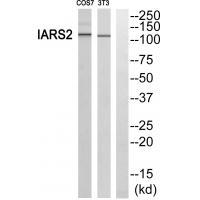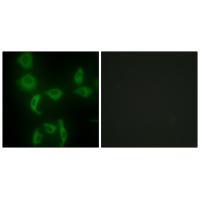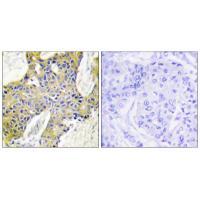


| WB | 1/500-1/3000 | Human,Mouse,Rat |
| IF | 咨询技术 | Human,Mouse,Rat |
| IHC | 1/50-1/100 | Human,Mouse,Rat |
| ICC | 1/100-1/500 | Human,Mouse,Rat |
| FCM | 咨询技术 | Human,Mouse,Rat |
| Elisa | 咨询技术 | Human,Mouse,Rat |
| Aliases | EC 6.1.1.5; isoleucine-tRNA synthetase 2; mitochondrial; |
| Entrez GeneID | 55699; |
| WB Predicted band size | 114kDa |
| Host/Isotype | Rabbit IgG |
| Antibody Type | Primary antibody |
| Storage | Store at 4°C short term. Aliquot and store at -20°C long term. Avoid freeze/thaw cycles. |
| Species Reactivity | Human,Mouse |
| Immunogen | Synthesized peptide derived from internal of human IARS2. |
| Formulation | Purified antibody in PBS with 0.05% sodium azide. |
+ +
以下是3篇与IARS2抗体相关的文献摘要信息(注:因IARS2研究较新,部分文献可能涉及基因功能而非直接抗体应用):
---
1. **文献名称**: *IARS2 mutations cause mitochondrial encephalopathy with infantile-onset epilepsy and intellectual disability*
**作者**: Takezawa Y. et al. (2018)
**摘要**: 该研究首次报道IARS2基因突变导致线粒体脑病的临床特征,通过Western blot和免疫组化验证患者细胞中IARS2蛋白表达显著降低,提示IARS2抗体在疾病诊断中的应用潜力。
---
2. **文献名称**: *Mitochondrial aminoacyl-tRNA synthetase deficiencies: towards therapeutic approaches*
**作者**: Diodato D. et al. (2016)
**摘要**: 综述了线粒体氨酰-tRNA合成酶(包括IARS2)的功能缺陷与疾病关联,强调利用特异性抗体(如IARS2抗体)检测蛋白表达水平在病理机制研究中的关键作用。
---
3. **文献名称**: *A novel homozygous IARS2 mutation presenting with peripheral neuropathy and cerebellar atrophy*
**作者**: Kahlert A.K. et al. (2020)
**摘要**: 报道一例新型IARS2纯合突变病例,通过免疫印迹实验证实患者成纤维细胞中IARS2蛋白几乎完全缺失,证明IARS2抗体在遗传性线粒体病分子诊断中的可靠性。
---
**注**:若需具体文献DOI或补充其他方向研究,请进一步说明。
The IARS2 antibody targets the isoleucyl-tRNA synthetase 2 (IARS2), a mitochondrial enzyme critical for protein synthesis in mitochondria. As a member of the aminoacyl-tRNA synthetase family, IARS2 catalyzes the attachment of isoleucine to its cognate tRNA, ensuring fidelity in mitochondrial translation. This enzyme is encoded by nuclear DNA and transported to mitochondria, where it supports oxidative phosphorylation by maintaining mitochondrial ribosome function.
Mutations in the IARS2 gene are linked to mitochondrial disorders, including Leigh syndrome, cataracts, and combined oxidative phosphorylation deficiency, often manifesting as neurodevelopmental defects, muscle weakness, or metabolic dysfunction. The IARS2 antibody serves as a vital tool for studying these pathologies, enabling detection of protein expression levels, subcellular localization, and mutation-related functional impairments.
In research, the antibody is utilized in techniques like Western blotting, immunofluorescence, and immunohistochemistry to investigate mitochondrial translation defects, energy metabolism disruptions, and tissue-specific IARS2 expression patterns. Its application extends to diagnostics, therapeutic development, and mechanistic studies of mitochondrial diseases, making it essential for understanding cellular energy regulation and genetic disorders tied to mitochondrial dysfunction.
×